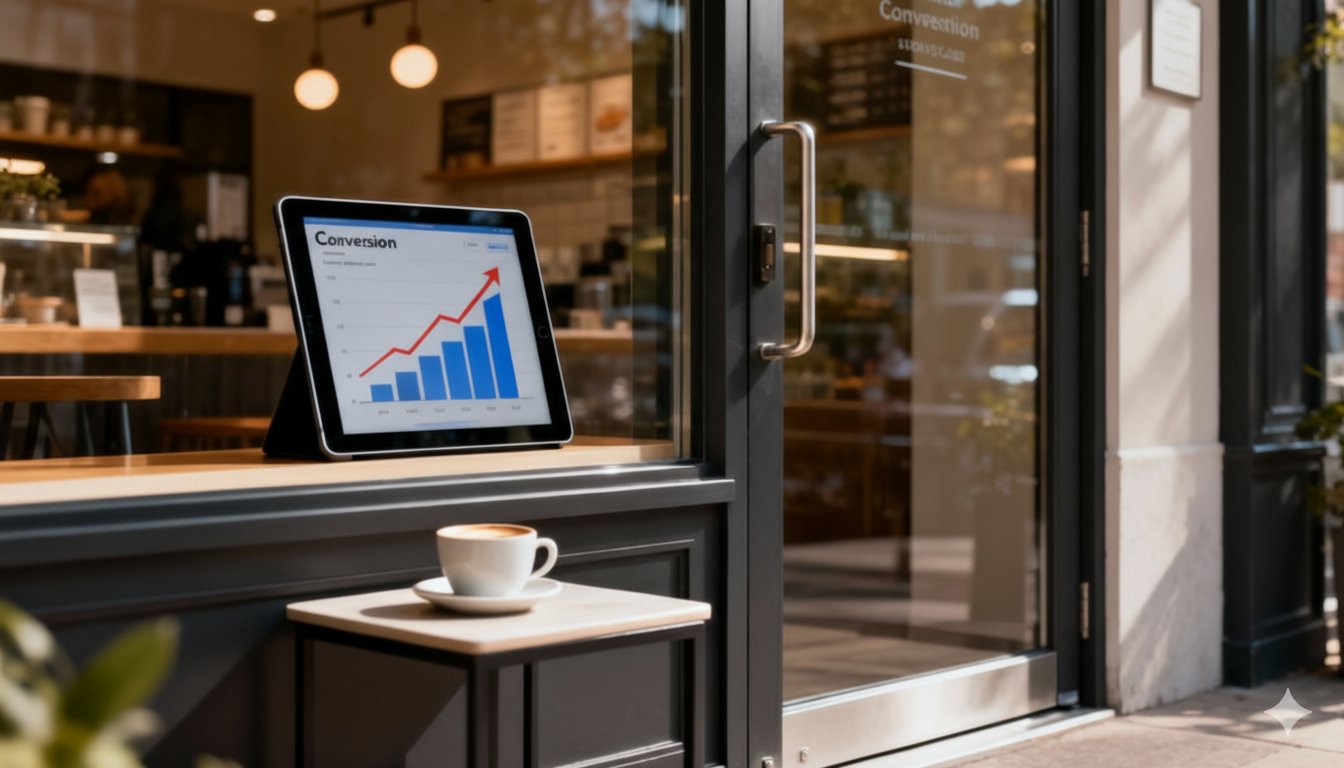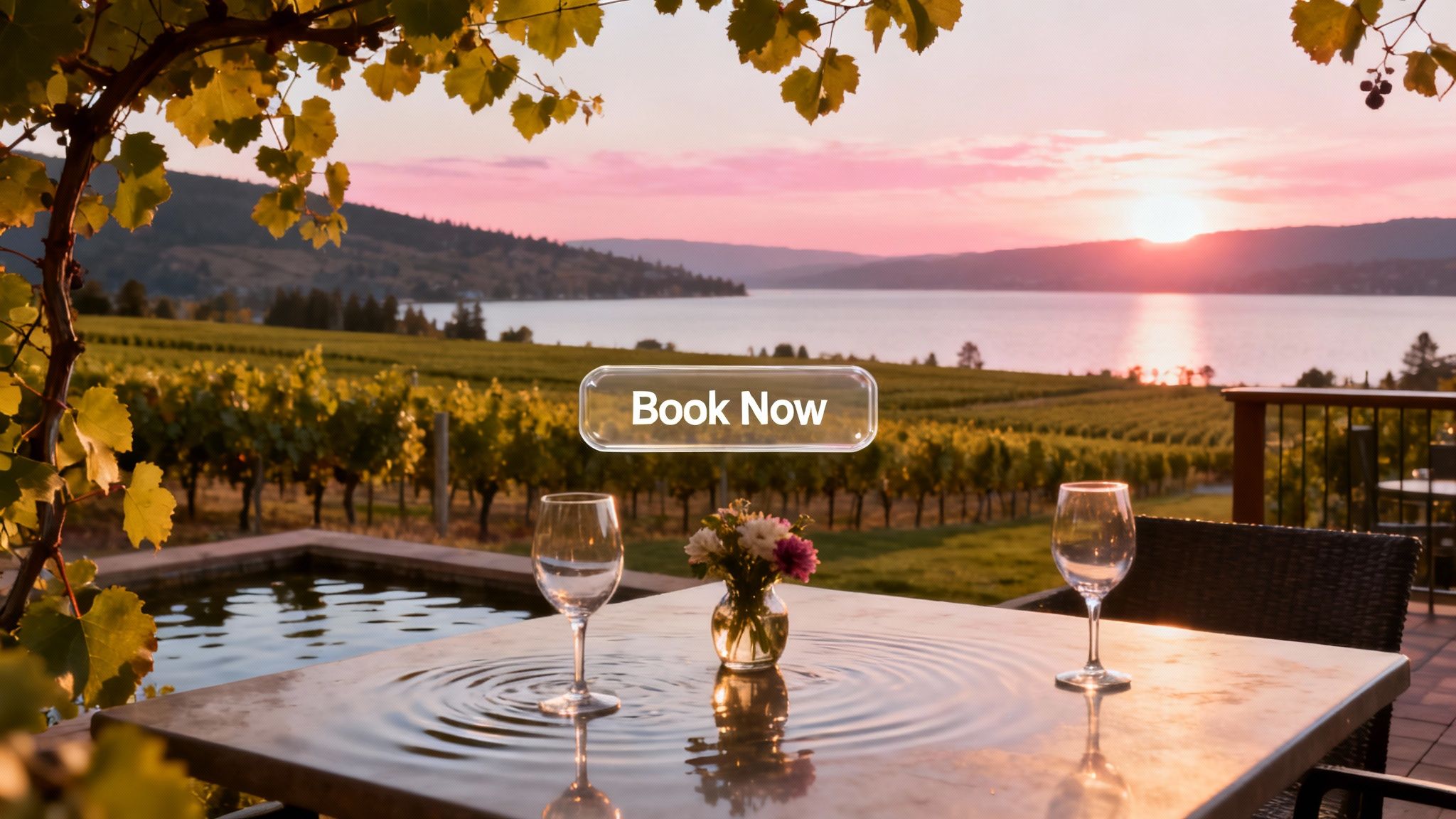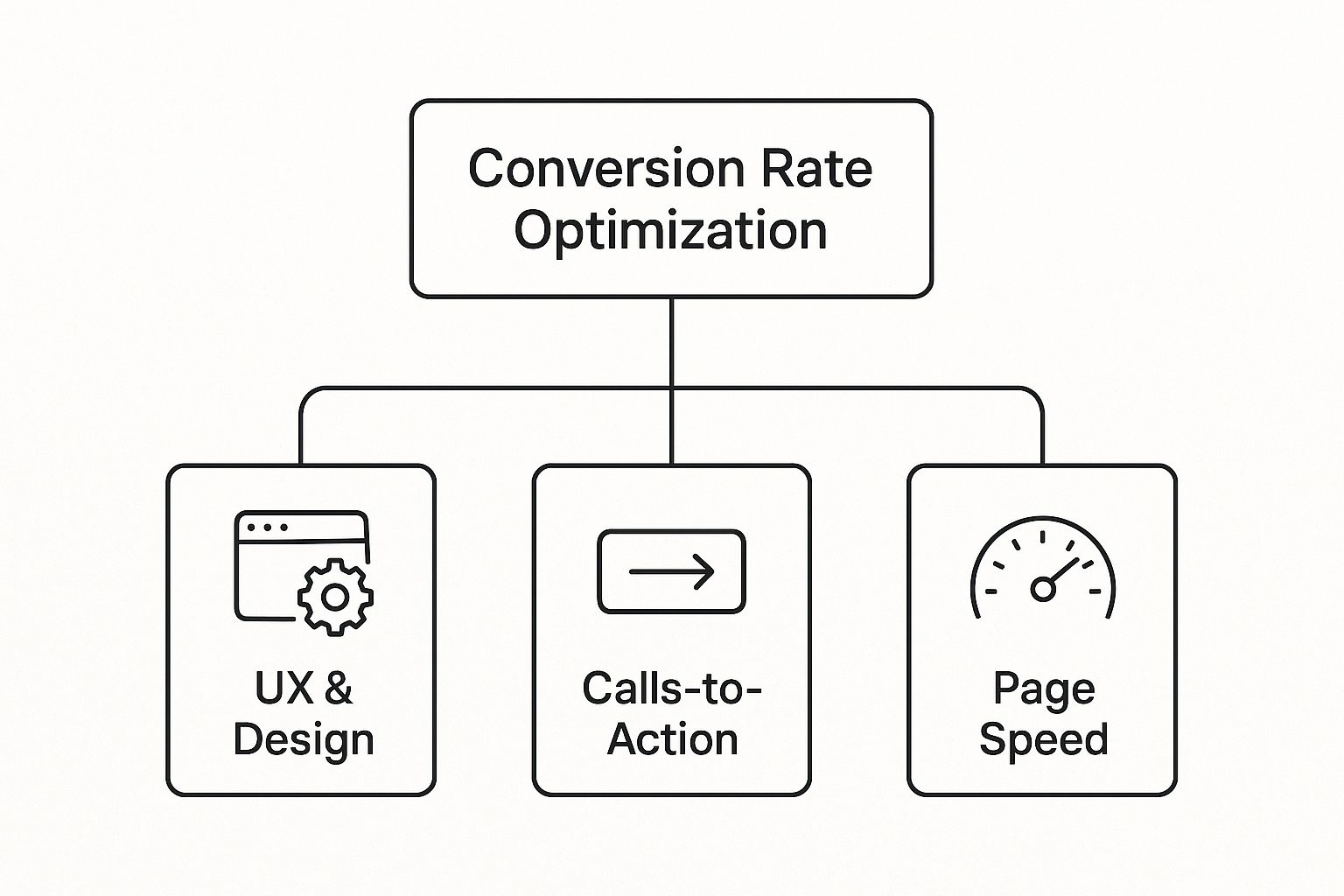What Is Conversion Rate Optimization? A No-Jargon Guide for Small Businesses
Let's grab a coffee and talk about your website for a moment. You’ve invested time, money, and a lot of heart into getting people there, right? Maybe they found you through a Google search, clicked on a social media post, or saw a local ad in the Okanagan. The big question is… are those visitors actually doing what you want them to do once they arrive?
This is where Conversion Rate Optimization, or CRO, comes into the picture. It's the process of fine-tuning your website to help more visitors take a specific, desired action. Think of it as making your online space as effective and persuasive as possible, turning casual browsers into committed customers or clients.
So What Is Conversion Rate Optimization, Really?
Imagine your website is your digital storefront right in downtown Kelowna. Getting traffic is like having people walk past your window. CRO is the art and science of making your entrance so inviting and your layout so intuitive that they can't help but come inside and take action.

It’s the secret sauce that makes your website work smarter, not just harder.
Turning Clicks into Customers
At its heart, CRO is all about understanding what makes your visitors tick. It involves digging into how people actually use your site and then making smart, data-backed changes to improve their journey.
This could mean:
-
Making a "Book a Tour" button bigger and a more eye-catching colour.
-
Simplifying the checkout process so people don't get frustrated and leave.
-
Rewriting a headline to be clearer and more compelling.
-
Making sure your phone number is easy to tap on a mobile device.
These small tweaks can lead to some seriously big results. For example, the average e-commerce conversion rate in Canada hovers around a modest 2.5% to 3%. That means for every 100 visitors, only two or three might actually buy something. A tiny bump in that number can have a huge impact on your bottom line. You can read more about these fascinating CRO statistics to see what we mean.
Basically, CRO helps make your website and your business more efficient. Let’s break down the core ideas.
Key CRO Concepts at a Glance
|
Concept |
What It Means for Your Business |
|---|---|
|
User Experience (UX) |
Making your site intuitive and enjoyable to use, so visitors find what they need without any frustration. |
|
Call-to-Action (CTA) |
The specific prompt you give visitors, like “Buy Now” or “Book a Showing.” CRO makes these CTAs irresistible. |
|
A/B Testing |
Showing two versions of a page to different users to see which one performs better. It’s a scientific way to prove what works. |
|
Conversion Funnel |
The path a visitor takes from landing on your site to completing a goal. CRO works to plug the leaks at every step. |
By focusing on these areas, you start building a website that guides visitors toward becoming loyal customers.
The whole point of CRO is to remove friction. We want to make it as easy as possible for a customer to say "yes" to whatever you're offering.
It’s a continuous process of listening, testing, and improving. When you focus on what your customers need, you create a website that not only looks great but also becomes your best salesperson. If you’re ever curious about how to get started, getting some expert help can provide a clear path forward.
Why CRO Is a Game-Changer for Okanagan Businesses
Living and working in the Okanagan is a dream, isn't it? From Penticton all the way up to Vernon, we're surrounded by incredible scenery. But that beauty also means we're in a competitive market. Whether you're running a West Kelowna winery, a local trades business, or a tourism company, you know that grabbing—and keeping—attention online is a real challenge.

Here's something to think about: getting people to your website is only half the job. You can pour money into ads to bring visitors in, but what actually happens once they arrive? This is exactly why understanding what is conversion rate optimization is so critical for local success.
CRO is all about making the most of the visitors you already have. You've already done the hard work to get them there; now, the goal is to make their experience so smooth and intuitive that taking the next step with you feels like a no-brainer.
From Just Looking to Actually Booking
Let's ground this in a real-world example. Imagine you run a stunning winery on the Westside Wine Trail. A tourist lands on your website, excited to plan their visit.
They’re greeted with beautiful, but painfully slow-loading, images of Okanagan Lake. The "Book a Tour" button is tiny, buried at the very bottom of the page. After a few seconds of frustration, they hit the back button and book with your competitor down the road. That's a lost sale, right there.
Now, let's paint a different picture:
-
Crisp, fast-loading photos immediately show off the best of your vineyard.
-
A big, impossible-to-miss "Book Your Tasting Now" button sits right at the top.
-
The booking form is a single, simple page that works flawlessly on their phone.
That's CRO in action. It’s about making small, smart tweaks that naturally guide visitors toward becoming customers. This same logic applies to any business in the valley—a plumber in Penticton could get more quote requests, or a real estate agent in Kelowna could book more property viewings.
Conversion rate optimization unlocks the true potential of the website you’ve already built. It transforms your site from a static online brochure into your most effective salesperson.
It’s a powerful way to grow your business without having to find a massive new marketing budget. You’re simply making your online presence more efficient and user-friendly.
And the best part? It puts you in the driver's seat. By understanding how people truly interact with your website, you can make data-backed decisions that lead directly to more leads, more sales, and sustainable growth. When you're ready to turn more of your hard-earned traffic into happy customers, we're here to help map out the next steps. It's what we do.
Understanding the Building Blocks of CRO
Alright, let's look under the hood. Conversion rate optimization isn't some magic trick; it's a careful mix of different elements all working in harmony. Think of it like a recipe—you need the right ingredients in the right amounts to get the perfect result.
When we really break down what conversion rate optimization is, it comes down to a few core pieces. This infographic lays out the main pillars we focus on: creating a great user experience, crafting clear calls-to-action, and making sure your site is lightning-fast.

Each one of these pillars supports the main goal—making it as simple and seamless as possible for a visitor to take the next step with your business. Let's dig into what each of these really means for your website.
Your Website Design and User Experience (UX)
First up is your website's design and how people feel when they use it. This is what we call User Experience, or UX. Is it genuinely easy for someone to find what they're looking for? Or is it a frustrating scavenger hunt?
Imagine a visitor lands on your site trying to find your phone number. If they have to click through five different pages and squint to find it buried in the footer, they're probably going to give up. That's a lost lead, right there. A good user experience means everything is intuitive, logical, and frustration-free.
Compelling Copy and Clear Words
Next, let’s talk about the words on your website. Your copywriting needs to be both compelling and crystal clear. It should speak directly to your ideal customer, answer their questions before they even ask them, and gently guide them toward taking that next step.
It’s all about using language that connects. For a local Kelowna business, for instance, that might mean using words that resonate with the Okanagan lifestyle. Your headlines, your product descriptions, and even the text on your buttons all play a part in telling a story that makes people want to engage.
Calls-to-Action That Actually Work
Those all-important buttons and links on your site? Those are your Calls-to-Action (CTAs). We're talking about things like "Get a Quote," "Book Now," or "Add to Cart." A core part of CRO is making sure these CTAs are impossible to miss and dead simple to understand.
Sometimes, a tiny change can make a massive difference. We use a method called A/B testing, where we test two versions of a button against each other to see which one gets more clicks. You can learn more about A/B testing in our detailed guide to see how this works in the real world.
A visitor should know exactly what will happen when they click a button, and they should feel confident doing it. We want to remove any hesitation.
Page Speed and Building Trust
Finally, two huge factors are speed and trust. In a world of instant gratification, nobody waits around for a slow website to load. If your site takes more than a few seconds, visitors will simply leave. Optimizing your page speed is a non-negotiable part of CRO.
Trust is just as critical. Things like customer reviews, testimonials, and clear contact information all help build credibility. A visitor needs to feel that your business is legitimate and trustworthy before they'll even think about handing over their contact details or credit card number.
Interestingly, when looking at Canadian websites, direct traffic—people who type your website address in directly—often has the highest conversion rate at 3.3%. This just goes to show how powerful brand trust is. It’s a foundation we help Okanagan businesses build every single day.
How to Discover What Needs Improving
So, where do you even start? It’s tempting to just start guessing—maybe a new button colour here, a different photo there. But real conversion rate optimization is more like being a detective than a decorator. We need to follow the clues, and thankfully, your website provides plenty of them.

It all comes down to listening to what your website data and your customers are telling you. We use specific tools to gather these clues, helping us pinpoint exactly where visitors are getting stuck, confused, or just plain giving up. This evidence-based approach means we make changes that are directly tied to business growth, not just shots in the dark.
Using Data to Find the Friction Points
The first place we look for clues is in your website analytics. Think of this as the digital equivalent of security footage for your storefront. It tells us which pages people flock to, how long they stick around, and—most importantly—where they decide to walk out the door.
For instance, if we see hundreds of people landing on your "Services" page but almost nobody clicks through to your contact form… that’s a huge red flag. It tells us there's a disconnect happening right on that page. Making sense of this data is a crucial first step, and it's something we dive deep into with our web analytics services.
A structured, data-driven approach to CRO is becoming the standard for top-performing Canadian businesses. Pinpointing exactly where the customer journey breaks down—whether it’s a slow mobile checkout or a vague call-to-action—is crucial. Effective CRO programs use both data and user feedback to refine every touchpoint, which is why even small gains can lead to significant growth.
Visual Tools that Tell a Story
Numbers are great, but sometimes you need to see the story unfold visually. That's where a few of our favourite tools come in handy to show us how people are actually interacting with your site.
-
Heatmaps: Imagine a weather map for your website. Heatmaps show us colour-coded visuals of where people click, tap, and scroll. Bright red spots are hot with activity, while cool blue areas are getting ignored. It’s a fantastic way to instantly see if that critical "Get a Quote" button is actually getting the attention it deserves.
-
Session Recordings: This is like looking over a visitor's shoulder as they browse your site (anonymously, of course!). We can watch their mouse movements, see where they hesitate, and spot the exact moments of frustration in real-time. It’s an incredibly powerful way to understand the real user experience.
These tools help us move from "I think this is a problem" to "I know this is a problem."
A/B Testing: Finding the Winner
Once we have a solid hunch about what needs fixing, we don’t just implement the change and hope for the best. We test it. This is where A/B testing becomes our best friend.
The concept is simple but incredibly powerful. We create two versions of a single page: Version 'A' is the original (the "control"), and Version 'B' has the one change we want to test. We then show Version A to half of your visitors and Version B to the other half, completely at random.
Maybe we test a green 'Book Now' button against your original blue one. Or perhaps we test a bold new headline against the old one. The test runs until we have enough data to declare a clear winner—the version that gets more people to take the desired action.
This process removes all the guesswork. Every improvement we make is backed by the behaviour of your actual users, ensuring we’re always moving in the right direction and turning more of your Okanagan traffic into happy customers.
Your Actionable Next Steps for Better Conversions
Feeling a bit overwhelmed by all this? That's completely normal. Honestly, most business owners we chat with here in Kelowna feel the exact same way when we first dig into what conversion rate optimization really means.
The great thing about CRO is that you don’t have to tear down your entire website and start from scratch. You can begin with small, common-sense checks that often make a surprisingly big difference. It's all about taking that first manageable step.
Start with a Simple Website Walkthrough
Before you even think about diving into complex data, just try putting yourself in your customers' shoes. Grab your phone and spend five minutes going through this quick checklist. You might be surprised by what you uncover.
-
Find Your Phone Number: Open your website on your mobile. Can you find your phone number in less than three seconds? More importantly, is it a "tap-to-call" link? If someone has to manually copy and paste your number to call, that’s a roadblock you can remove in minutes.
-
Read Your Homepage Out Loud: No, seriously, try it. Does it sound like something a real person would actually say? Or is it full of stiff, corporate jargon? Your website should sound like you—approachable and genuine.
-
Check Your Forms: Go to your contact form and take a hard look. Are you asking for too much information upfront? A simple form asking for a name, email, and message is far less intimidating—and more likely to be completed—than one demanding a phone number, address, and budget right away.
These small actions are the very heart of conversion optimization. They’re all about spotting the tiny hurdles that might be preventing a potential customer from getting in touch.
We want to make it as easy as possible for someone to say "yes" to your business. Every little improvement helps clear the path for that to happen.
Let's Tackle This Together
If you’ve done this quick audit and are already thinking you'd rather have a partner to help you see the bigger picture, that’s exactly what we’re here for. We genuinely love digging into this stuff and figuring out what makes a website truly work for local businesses in the Okanagan.
We believe in working with our clients, not just for them. It’s a partnership built on straight talk and real, measurable results.
If you have a feeling your website isn’t pulling its weight, we can help you turn it into your hardest-working employee. When you're ready to see what’s possible, just reach out and let's have a chat. No pressure, just a friendly conversation about your goals.
We Get Asked This A Lot…
The world of digital marketing can feel like a bowl of alphabet soup. When we sit down with local business owners, whether they're here in Kelowna or across the Okanagan, the same questions about conversion rate optimization tend to pop up.
Let's clear the air and answer them right here, in plain English.
How Long Does CRO Take to Work?
This is the big one, and the honest-to-goodness answer is: it depends. CRO is a process, not a magic wand for instant results. First, we need to gather enough data to understand what's actually happening on your website, which usually takes a few weeks.
Then, we start running tests. Each test needs to run long enough to give us reliable, statistically significant results—that could be another few weeks or even a month. You might see some "quick wins" pop up early on, but a proper CRO strategy is all about steady, ongoing improvement. The real value comes from learning from every single test and building on that knowledge over time.
Isn't CRO Just Another Name for SEO?
It’s easy to get them mixed up, but they have two very different jobs. Think of them as a tag team.
Search Engine Optimization (SEO) helps people find your website in the first place. It’s the art of showing up on Google when someone searches for what you offer. It opens your digital front door to more visitors.
Conversion Rate Optimization (CRO) focuses on what happens after they step inside. It makes their experience so smooth and compelling that they take the next step and become a lead or a customer. They're powerful partners: great SEO brings in the crowd, and great CRO turns that crowd into business. A free website and SEO audit is a great way to see where you stand on both.
Does CRO Even Matter for a Service Business?
One hundred percent, yes! This is a huge misconception. A 'conversion' is not just about an e-commerce sale.
For a service-based business right here in the Okanagan, a conversion could be a potential client filling out your contact form, calling your business, or booking a consultation. It’s any meaningful action that brings a website visitor closer to becoming a customer.
For a plumber, a real estate agent, or a consultant, CRO is all about fine-tuning your website to generate more of those valuable leads. We focus on making your value crystal clear, building trust with testimonials, and ensuring your contact information is dead-simple to find.
Do I Need Tons of Traffic to Do CRO?
Not at all. While having a flood of website traffic lets you get results from A/B tests much faster, you absolutely don't need to be a huge brand to start with CRO. This myth holds so many small businesses back.
Even with lower traffic, we can use incredibly insightful tools like heatmaps, session recordings, and simple customer surveys to understand user behaviour. This "qualitative" data often reveals major pain points or quick-win opportunities right away. For many small businesses, we start here, making smart, data-informed changes before we even think about formal A/B testing.
At Navigator Multimedia, our job is to make this stuff simple and make it work for your business. If your website isn’t performing like it should, we can help turn it into your most effective salesperson. Contact us and let's have a chat about it.



